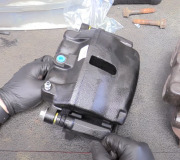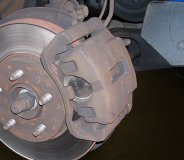Here's my wondrous reply for your reading pleasure. Let me know if I can add any details.
The main factor is "coefficient of friction", meaning how hard the linings grab under a given pressure. If an aftermarket brake pad or shoe grabs harder with less pedal force, it will be manufactured with a smaller surface area. This is easiest to see in rear shoes. Stickier linings will be shorter so overall they don't lock up before the front brakes have reached their maximum stopping power.
The next variable has to do with the "proportioning" valve. That limits the amount of brake fluid pressure going to the rear brakes to prevent early rear-wheel lock-up. That valve normally lives in the combination valve under the master cylinder, and is calibrated for the specific car model. It takes into account front-to-rear weight distribution and weight transfer during braking. That means it will be different for identical models with different options such as engine size, larger radiator, and with or without AC.
One of the little-known design requirements is a vehicle's braking system must be able to hold it from moving when the throttle is wide-open. To say that a different way, the brakes are stronger than the engine. That's why upgrading to a larger engine often includes a larger brake system in the package along with a heavy duty cooling system.
Also, every brake system is strong enough to lock up all four wheels. "Upgrading" to something stronger won't make the vehicle stop any faster. In fact, a skidding tire has no traction. That's why rear-wheel anti-lock brakes originally showed up on older pickup trucks. It was designed to prevent the rear end from passing up the front end under hard braking.
The proportioning valve goes back to at least the 1950s. As I mentioned, it limits how high brake fluid pressure can get to the rear wheels. The next two improvements showed up in the 1980s. One was the rear anti-lock brakes which was a very basic but effective system compared to the newer four-wheel-ABS. The other is the "rear height-sensing proportioning valve". That moves the valve from the combination valve under the master cylinder to the rear axle. They're used on minivans and small trucks because those models can have such a wide range of loading from "empty" to hundreds of pounds of people or cargo. A fully-loaded vehicle needs more braking power in the rear to shorten stopping distances. That valving would result in real easy and touchy rear-wheel lockup with no load. The rear height-sensing proportioning valve adjusts for any loading condition to provide the strongest rear brakes without the worry of lockup.
Four-wheel anti-lock brakes is the way to achieve the shortest stopping distances, but that doesn't apply to all models. In a panic situation, remember, a skidding tire has no traction. Momentum keeps the car going straight regardless of what you do with the steering wheel. If you want to stop as quickly as possible to avoid a crash, what you have to do the instant you hear a tire skidding is to let up a little on the brake pedal to get that wheel rotating again. That restores that wheel's traction and steering ability. The problem is you had three brakes that were not locked up, yet you let up on the brake pedal. Those three have considerable unused stopping power.
Four-wheel ABS takes care of that. These systems look at the wheel that's rotating fastest, and disregards that one. Of the remaining three, the computer watches to see which one is a certain percentage slower than the other two. That slower wheel gets a closed "block" valve that stops additional brake fluid flow to that brake, even if you push harder on the brake pedal. If that wheel doesn't come back up to speed, a "dump" or "bleed" valve opens to bleed off some of that brake fluid pressure. Once the wheel gets back up to speed, an "apply" valve opens to pass pressurized brake fluid to that brake to reapply it. That process repeats from 15 to 30 times per second until the function isn't needed or until the vehicle gets down to around 9 � 15 mph. That's the buzzing you hear and feel.
Where the difference comes in is in how the manufacturer designs their systems. In the case of my '93 Dynasty, all four wheels have their own channel in the computer, and any one or more brakes can be modulated independently. They used the "Bendix-10" system that used ten valves. GM used a similar "Bendix-9" system in their Caprice Classic. One less valve reduced cost, but it puts both rear brakes on a single channel. If either rear wheel goes into a skid condition, brake fluid pressure is reduced to both wheels, even though one isn't skidding. There has to be some other differences I'm not aware of. A friend who is a retired county deputy told me he could stop a Caprice squad car faster when it didn't have that ABS system. With the ABS system, the car would, "go and go and go, and they'd find me in the next county", as he put it, but that brings up the entire point of anti-lock brakes. They were specifically designed to maintain steering control. That is lost when a tire skids. The shorter stopping distances are just a delightful side effect. With my Dynasty, stopping on sand from a fairly high speed can just about tear the seatbelts off their hinges.
The last issue is less common but worth mentioning. That has to do with switching from drum to rear disc brakes. I've seen people do this with "unreasonable expectations" and disappointing results. Drum brakes on larger vehicles are "self-energizing". Basically that means they want to grab harder and harder on their own. To get disc brakes to grab harder, a lot more pedal effort is needed. This is why we needed to add a power booster in the 1960s. Rear drum brakes can already lock up. Disc brakes can't improve on that. That's where it is unreasonable to expect to achieve shorter stopping distances.
There are two advantages to having disc brakes in the rear. One only applies to vehicles with four-wheel ABS. Shoes need considerable time to retract. Spring tension has to pull the shoes back, and the shoes have to move a lot of brake fluid back to the reservoir. Shoes can't be pulsed 15 times per second. Even though a disc brake piston has a much larger area, very little brake fluid moves to apply them. It's easy to pulse calipers many times per second making them much more effective for ABS systems.
The second issue is brake fade. Being open to air flow, disc brake pads run cooler than shoes. The coefficient of friction has to remain fairly constant under varying temperatures to maintain front-to-rear brake balance, but two things can happen. "Off-gassing" is when material in the linings vaporizes. That acts like little ball bearings between the drum and the linings.
Brake fade also occurs when the binders in the linings melt and form glazing. Once cooled, that material has a lower coefficient of friction
compared to what the lining had.
What people overlook when changing to rear disc brakes, even when using optional factory parts, is this is still a complete system. Front caliper piston diameter may be different depending on which type of rear brake is used. With rear drum brakes, there's a "residual check valve" in that port in the master cylinder. That maintains ten pounds of pressure on the brake fluid to prevent air from entering past the lip seals in the wheel cylinders when barometric pressure goes up overnight. If that master cylinder isn't replaced when switching to rear disc brakes, that valve will keep the rear brakes applied all the time.
Now for the good news. No upgrade will make your vehicle stop any faster, but as long as the braking balance isn't altered, anything that keeps the linings cooler will reduce the loss of braking power from brake fade. If slotted rotors would help, they would have been original equipment. I'm not convinced, but they can't hurt. Ceramic brake pads are considered an upgrade, but again, they can't be allowed to provide more stopping power than the original linings had. They're less susceptible to fade, but more likely to squeal in humid conditions. I've also heard they have to get warmed up to achieve their correct coefficient of friction. That would imply they're less effective when seeing little use on long trips. These would be a better choice for high performance applications or for extensive city driving.
The consensus among a group of national-level instructors is the manufacturers with the best "customer-friendly" business practices are Hyundai, Toyota, and Chrysler, in that order. One of those practices is to put safety ahead of cost. You're going to find Toyota didn't skimp and risk their reputation on wimpy brakes. That's the job of other U.S manufacturers. It's when there isn't much room for improvement that you won't find much in the way of upgrades from the aftermarket suppliers.
SPONSORED LINKS
Monday, January 10th, 2022 AT 4:01 PM




